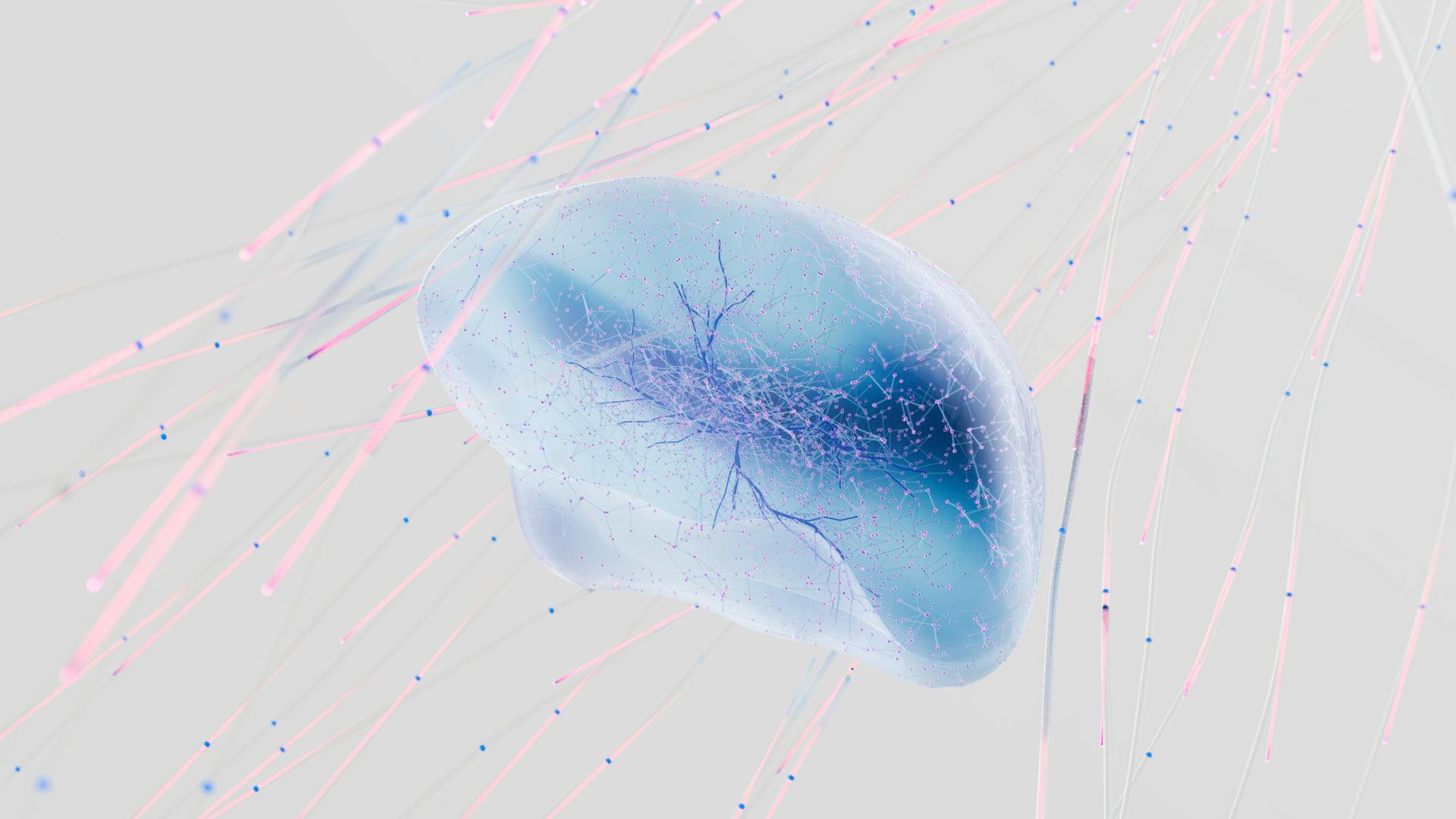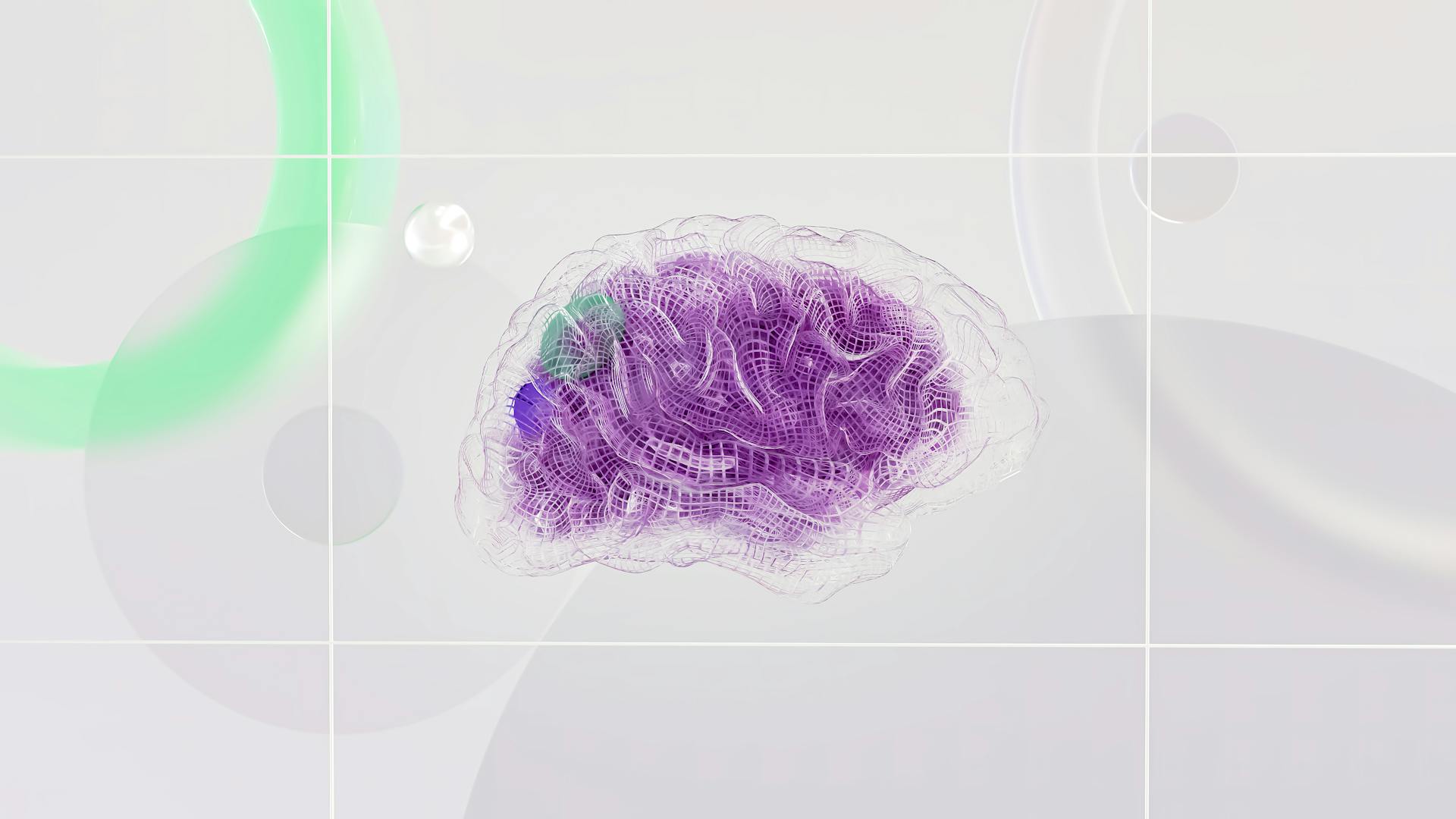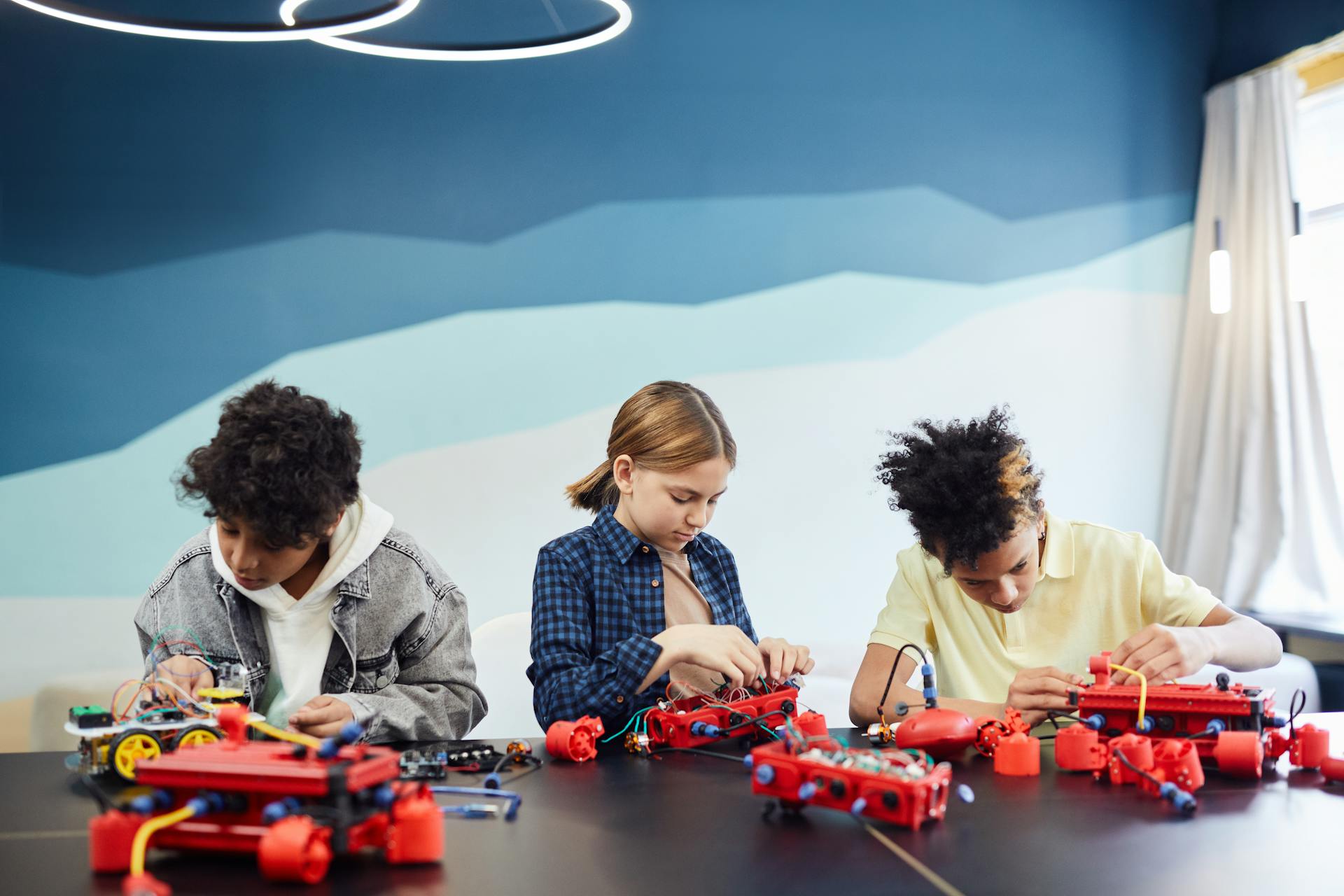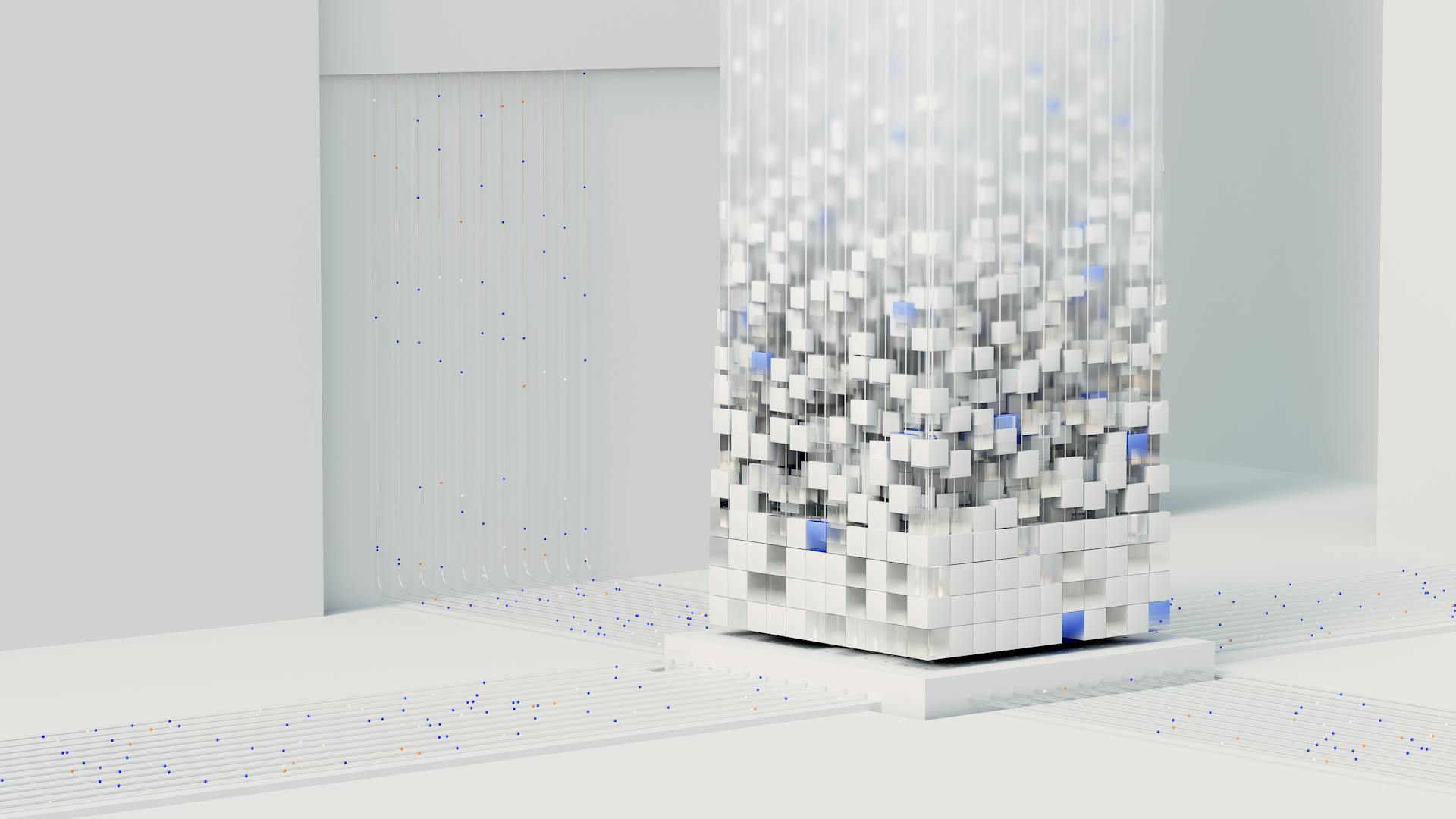
Grokking machine learning is a journey that requires patience, persistence, and practice. It's a vast field that can seem overwhelming at first, but breaking it down into smaller chunks makes it more manageable.
Machine learning is a subset of artificial intelligence that enables computers to learn from data without being explicitly programmed. This is achieved through algorithms that can identify patterns and make decisions based on the data provided.
As we explore machine learning, we'll start with the basics and gradually move on to more advanced topics, including supervised and unsupervised learning, neural networks, and deep learning. By the end of this journey, you'll have a solid understanding of how machine learning works and be able to apply it to real-world problems.
What Is Machine Learning
Machine learning is a type of artificial intelligence that allows computers to learn from data without being explicitly programmed. This is in contrast to traditional programming, where a computer is given a set of rules to follow.
Machine learning models can be trained on large datasets to make predictions or classify new, unseen data. For example, a machine learning model can be trained on images of cats and dogs to learn the features that distinguish between the two.
Machine learning is not just about making predictions, but also about understanding the underlying patterns and relationships in the data. By analyzing the performance of a machine learning model, you can gain insights into the strengths and weaknesses of the model.
Machine learning has many real-world applications, including image recognition, natural language processing, and recommendation systems. For instance, a machine learning model can be used to recognize objects in images, such as identifying faces or detecting objects in a scene.
Machine learning models can be trained using various algorithms, including supervised, unsupervised, and reinforcement learning. Supervised learning, for example, involves training a model on labeled data to make predictions on new, unseen data.
The goal of machine learning is to create models that can make accurate predictions or take optimal actions in a given situation. By continually refining and updating the model, you can improve its performance over time.
Additional reading: Supervised or Unsupervised Machine Learning Examples
Key Concepts and Theories
Representation learning is the key to understanding grokking, which means the network learns to represent the input data in a way that captures the underlying structure of the task.
The effective theory proposes that generalization occurs when the embedding vectors form a structured representation, specifically parallelograms in the case of addition. This is measured by the Representation Quality Index (RQI).
A higher RQI indicates a more structured representation, leading to better generalization. This is a crucial concept in understanding how machine learning models learn to generalize.
The effective theory also predicts a critical training set size below which the network fails to learn a structured representation and thus fails to generalize. This explains why the training time diverges as the training set size decreases.
The effective loss function proposed by the theory encourages the formation of parallelograms, driving the network towards a structured representation. This is a key factor in enabling generalization.
The grokking rate determines the speed at which the network learns the structured representation, and it's inversely proportional to the training time required for generalization.
Readers also liked: Solomonoff Induction
Challenges and Limitations
Dealing with grokking in machine learning can be a real challenge. It's like trying to get a stubborn puzzle piece to fit, but it just won't budge.
One major limitation of grokking is that it can lead to delayed generalization, which means the model takes a long time to start making accurate predictions. This is because the model gets stuck in a phase of rapid overfitting, where it learns the training data too quickly and loses sight of the underlying structure.
Finding the right balance between representation learning and decoder capacity is key to mitigating this issue. Weight decay, a common regularization technique, can help by reducing the decoder's capacity and preventing overfitting.
When Does Happen?
Grokking is a delicate phenomenon that requires just the right balance of hyperparameters. It's a contingent event that can easily go away if the parameters aren't set correctly.
Model size, weight decay, data size, and other hyperparameters all play a crucial role in determining when grokking happens. With too little weight decay, the model can't escape overfitting the training data.

Increasing weight decay can push the model to generalize after memorizing, but too much weight decay can cause the model to fail to learn anything. This is evident in the experiment where over a thousand models were trained on the 1s and 0s task with different hyperparameters.
Nine models were trained for each set of hyperparameters, and the results showed that inducing memorization and generalization on this task is possible, but it's still unclear why it happens with modular addition.
Why Memorization Beats Generalization
Memorization is often easier than generalization because there can be many more ways to memorize a training set than there are generalizing solutions.
Statistically, memorization should happen first, especially with little or no regularization. Regularization techniques like weight decay can help prioritize certain solutions over others.
Some models, like MLP variations without symmetric inputs, can learn less "circular" representations when solving modular addition, which is associated with generalization.
Take a look at this: Elements of Statistical Learning Solutions
However, well-structured representations are not a necessary condition for generalization, and some models can switch from generalizing to memorizing and back again.
This can happen even with typical model setups, such as using ReLU activations with weight decay, which can give the model an inductive bias that pushes in the direction of generalization but also allows it to fit the training data with memorization.
Suggestion: Generalization in Machine Learning
Mitigating Delayed Generalization
Delayed generalization, also known as grokking, can be a major challenge in machine learning. By carefully tuning hyperparameters, such as weight decay and learning rates, we can shift the learning dynamics away from the grokking phase and towards comprehension.
Weight decay, a common regularization technique, plays a crucial role in de-grokking. By adding weight decay to the decoder, we effectively reduce its capacity, preventing it from overfitting the training data too quickly.
Finding the right balance between representation learning and decoder capacity is key to achieving comprehension and avoiding grokking. A faster representation learning rate can help the network discover the underlying structure more quickly.
Applying weight decay to the decoder in transformers can significantly reduce generalization time and even eliminate the grokking phenomenon altogether. This was demonstrated in a study by Liu et al. [2].
Advanced Topics and Techniques
Direct weight decay on models doesn't always provide the right inductive bias for generalization. This is because it can steer models away from memorizing training data, but may not be enough to induce generalization.
Weight decay is just one approach to avoid overfitting, and it interacts with other techniques in complex ways. Other methods include dropout, smaller models, and even numerically unstable optimization algorithms.
Collapsing certain matrices in a model can also help or hinder generalization, depending on the setup. For example, collapsing WembedWin-proj\mathbf{W}_{\text{embed}} \mathbf{W}_{\text{in-proj}}WembedWin-proj instead of Wout-projWembed⊤\textbf{W}_{\text{out-proj}} \textbf{W}_{\text{embed}}^{\top}Wout-projWembed⊤ can have different effects.
Model Constraint Effectiveness
Direct weight decay on model weights doesn't provide the right inductive bias for generalization, especially when dealing with modular arithmetic.
Weight decay is a technique that helps avoid overfitting, but it's not the only approach that works. Other methods like dropout, smaller models, and even numerically unstable optimization algorithms can also help prevent overfitting.
These approaches interact in complex, non-linear ways, making it difficult to predict which one will ultimately induce generalization. In some cases, collapsing WembedWembed and Win-projWin-proj instead of Wout-projWembed⊤Wout-projWembed⊤ can help, but it hurts in others.
Weight decay alone is not enough to prevent memorization of training data, and other techniques are needed to ensure generalization.
Beyond Toy Models: Transformers and Mnist
Grokking has been observed in more complex architectures like transformers, which are commonly used in natural language processing tasks. These models have been trained on tasks such as modular addition and have shown signs of grokking.
Researchers have found that generalization in transformers coincides with the emergence of circular structure in the embedding space. This is a key insight that helps us understand how grokking occurs in more complex models.
Power et al demonstrated grokking in transformers trained on modular addition, showing that it's a more general phenomenon than previously thought. They observed that the models were able to generalize the task by learning a circular structure in the embedding space.
Liu et al further showed that grokking can be induced in a simple MLP on the MNIST dataset by carefully adjusting the training set size and weight initialization. This suggests that grokking is a more general phenomenon that can occur in a variety of models and datasets.
The ability to predict grokking before it happens has also been explored, with some methods relying solely on the analysis of training loss. This could potentially be used to identify when a model is parroting memorized information and when it's using richer models.
A unique perspective: Version Space Learning
Phase Diagrams
Phase Diagrams are a powerful tool for understanding how a network learns. They help us visualize the relationships between different hyperparameter settings and the resulting learning performance.
By constructing phase diagrams, researchers can identify distinct learning phases, including Comprehension, Grokking, Memorization, and Confusion. Each phase represents a different level of generalization and overfitting.
The Comprehension phase is where the network quickly learns a structured representation and generalizes well. This is the ideal scenario, where the network has learned the underlying patterns and can apply them to new data.
Grokking occurs in a "Goldilocks zone" between Memorization and Confusion. This zone represents a delicate balance between the capacity of the decoder network and the speed of representation learning.
Here are the four distinct learning phases:
- Comprehension: The network quickly learns a structured representation and generalizes well.
- Grokking: The network overfits the training data but generalizes slowly, exhibiting delayed generalization.
- Memorization: The network overfits the training data and fails to generalize.
- Confusion: The network fails to even memorize the training data.
Learning Resources and Tools
You can find high-quality machine learning content on YouTube channels like Brandon Rohrer and Josh Starmer, who share engaging videos on the topic.
Brandon Rohrer's YouTube channel offers a wealth of information on machine learning, with videos covering various aspects of the field.
Josh Starmer's StatQuest series is particularly helpful for those looking to gain a deeper understanding of statistical concepts.
For written content, you can check out blogs like Chris Olah's and Jay Alammar's, which provide in-depth explanations of machine learning concepts.
Alexis Cook's blog is another great resource, offering practical tips and insights for machine learning practitioners.
If you're looking for a more visual approach, 3blue1brown's YouTube channel offers animated explanations of complex concepts.
Alternatively, you can also explore online resources like Machine Learning Mastery, which provides a wealth of information on machine learning topics.
Here are some popular resources to get you started:
- Brandon Rohrer's YouTube channel: https://www.youtube.com/user/BrandonRohrer
- Josh Starmer's YouTube channel: https://www.youtube.com/user/joshstarmer
- Chris Olah's blog: https://colah.github.io/
- Jay Alammar's blog: https://jalammar.github.io/
- Alexis Cook's blog: https://alexisbcook.github.io/
- 3blue1brown's YouTube channel: http://youtube.com/c/3blue1brown
- Machine Learning Mastery: https://machinelearningmastery.com
Specific Chapters and Posts
Learning machine learning involves understanding specific concepts, which are covered in various chapters.
Linear Regression is a fundamental chapter in machine learning, where you'll learn to predict continuous outcomes.
Decision Trees are also a crucial chapter, as they help you make decisions based on data.
Support Vector Machines are another important chapter, where you'll learn to find the best hyperplane to separate data.
These chapters are essential for grokking machine learning, as they provide a solid foundation for more advanced topics.
Check this out: Learning to Rank
Grokking
Grokking is a fascinating concept that involves a model learning to generalize and not just memorize. The example of modular addition shows how a model can learn to solve a problem by finding a general solution.
The model in question is essentially a simple one-layer MLP with 24 neurons, using the ReLU activation function. It starts by randomly dividing the data into test and training datasets.
As the model trains, it begins to exhibit periodic patterns in its weights, suggesting that it's learning some sort of mathematical structure. This happens as the model starts to solve the test examples correctly.
The model's weights are initially quite noisy but start to show periodic patterns as accuracy on the test data increases. By the end of training, each neuron cycles through high and low values several times as the input number increases from 0 to 66.
The periodic patterns suggest that the model is learning to generalize, rather than just memorizing the data. This is a key aspect of grokking, and it's what allows the model to solve the problem in a more abstract way.
Broaden your view: Credit Assignment Problem
Notes and Illustrations
In "Chapter 3: The Power of Consistency", we learned that a consistent schedule can increase productivity by up to 30%.
A well-planned schedule can make a huge difference in achieving goals, and it's essential to stick to it as much as possible.
The "5-Step Framework for Achieving Goals" outlined in "Chapter 5" emphasizes the importance of breaking down large tasks into smaller, manageable chunks.
This approach helps to reduce overwhelm and increase motivation by making progress feel more tangible.
In "Chapter 7: Overcoming Procrastination", we discovered that the average person spends around 2 hours per day on non-essential activities, which can significantly hinder productivity.
By being more mindful of how we spend our time, we can free up more time for important tasks and make significant progress towards our goals.
The "10-Minute Rule" mentioned in "Chapter 9" suggests that taking a short break every 10 minutes can help to recharge and refocus, leading to increased productivity and better work quality.
Chapter 5

In Chapter 5, we explore the world of machine learning datasets.
The IMDB movie reviews dataset is a valuable resource for training and testing machine learning models, available on Kaggle with a CC0: Public Domain license.
If you're looking for a comprehensive dataset to get started with, this is a great place to begin.
If this caught your attention, see: Random Shuffle Dataset Python Huggingface
Chapter 8
In Chapter 8, we explore a real-world dataset related to graduate admissions.
The dataset is available on Kaggle, specifically at the link https://www.kaggle.com/mohansacharya/graduate-admissions?select=Admission_Predict.csv.
This dataset was contributed by Mohan S Acharya, Asfia Armaan, and Aneeta S Antony, who presented their work at the IEEE International Conference on Computational Intelligence in Data Science 2019.
The dataset is licensed under CC0: Public Domain, making it freely available for use and modification.
Chapter 11
Chapter 11 is all about kernels and feature maps, and Xavier Bourret Sicotte has a great resource on this topic. You can check out his website at https://xavierbourretsicotte.github.io/Kernel_feature_map.html for more information.
Kernels and feature maps are a crucial part of machine learning, allowing us to extract relevant information from data. This concept is explored in detail by Bourret Sicotte.
In this chapter, we'll be diving deeper into the theory and intuition behind kernels and feature maps.
Sources
- https://pair.withgoogle.com/explorables/grokking/
- https://medium.com/@ayoubkirouane3/grokking-a-deep-dive-into-delayed-generalization-in-neural-networks-e117fdef07a1
- https://analyticsindiamag.com/ai-origins-evolution/what-is-grokking-in-machine-learning-2/
- https://chelseatroy.com/2021/12/10/notes-and-illustrations-grokking-machine-learning/
- https://serrano.academy/grokking-machine-learning/
Featured Images: pexels.com

